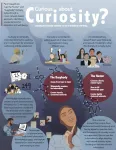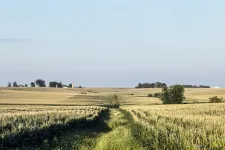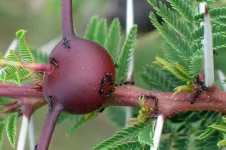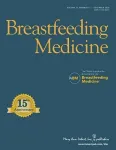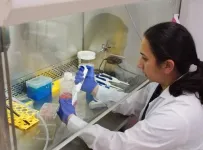Efforts to better understand what curiosity actually looks like for different people have underappreciated roots in the field of philosophy. Varying styles have been described with loose archetypes, like "hunter" and "busybody" -- evocative, but hard to objectively measure when it comes to studying how people collect new information.
A new study led by researchers at the University of Pennsylvania's School of Engineering and Applied Science, the Annenberg School for Communication, and the Department of Philosophy and Religion at American University, uses Wikipedia browsing as a method for describing curiosity styles. Using a branch of mathematics known as graph theory, their analysis of curiosity opens doors for using it as a tool to improve learning and life satisfaction.
The interdisciplinary study, published in Nature Human Behavior, was undertaken by Danielle Bassett, J. Peter Skirkanich Professor in Penn Engineering's Departments of Bioengineering and Electrical and Systems Engineering, David Lydon-Staley, then a postdoctoral fellow in her lab and now an assistant professor in the Annenberg School of Communication, two members of Bassett's Complex Systems Lab: graduate student Dale Zhou and postdoctoral fellow Ann Sizemore Blevins, and Perry Zurn, assistant professor from American University's Department of Philosophy.
"The reason this paper exists is because of the participation of many people from different fields," says Lydon-Staley. "Perry has been researching curiosity in novel ways that show the spectrum of curious practice and Dani has been using networks to describe form and function in many different systems. My background in human behavior allowed me to design and conduct a study linking the styles of curiosity to a measurable activity: Wikipedia searches."
Zurn's research on how different people express curiosity provided a framework for the study.
"Each curiosity style has its own 'kinesthetic signature' that describes how a person naturally searches for information," says Zurn. "For example, the 'hunter' style is characterized by the seeking of closely related information, aiming to dive deeply into a certain topic, while the 'busybody' jumps from topic to topic, collecting loosely connected information."
The study was comprised of 149 participants, who were instructed to browse Wikipedia for 15 minutes a day over the course of 21 days. With no further instructions on what pages to visit, the participants' paths through the site revealed the kinesthetic signatures of their curiosity styles.
"Wikipedia allowed both introverts and extroverts to have equal opportunity in curious practice, a limitation in other studies of curiosity, while the ad-free search engine allowed individuals to truly be captains of their own curiosity ships," says Bassett.
While browsing, data was recorded as knowledge networks where each unique Wikipedia page visited became a node and the relatedness between Wikipedia pages, determined by text similarity between two pages, created the thickness of the edges between the nodes.
Participants with the hunter curiosity style exhibited a tight network with relatively high clustering of nodes, thick edges, and short overall path lengths. Those with the busybody curiosity style exhibited a looser network with nodes further separated by thin connecting edges and longer path lengths.
The signatures of a participant's curiosity style were not written in stone, however.
"We found that people are curious in their own ways and fall in and out of different styles, shown by changes in the knowledge network structures over time. We then wanted to understand the drivers of these changes," says Bassett.
To better understand the factors that influence which curiosity style a person might use, the researchers surveyed the participants on indicators of well-being in a laboratory visit before their Wikipedia browsing began. These indicators included "deprivation sensitivity," or the tendency to seek information in order to fill knowledge gaps, and "sensation seeking," or the tendency to seek novel and exciting information. Other factors recorded participants' tendencies to browse topics for fun, seek out social interaction, and tolerate stress. The information from these surveys was incorporated in the models of the knowledge networks, allowing the team to assess the mechanisms behind curiosity styles.
"We hypothesize that a switch from hunter to busybody style might arise due to sensation seeking, or the craving for novelty and new information during the day," says Bassett.
"By measuring a person's level of sensation seeking before each Wikipedia browsing session, we found that people tended to take larger steps between nodes when the tendency to seek new information was high," says Lydon-Staley, creating a loose knowledge network.
The participants who originally scored higher in deprivation sensitivity tended to form tighter networks as they sought information to fill knowledge gaps. This network structure indicated the hunter style of information seeking. For example, one participant searched for "History of the Jews in Germany," "Hep-Hep riots," "Zionism," "Nathan Birnbaum," and "Theodor Herzl," all centralized around Jewish history.
On the other end of the spectrum, participants who reported lower deprivation sensitivity exhibited a knowledge network characterized by thinner links, more loosely connected topics, and longer overall network paths. An example of this style is a Wikipedia search for "Physical chemistry," "Me Too movement," "The Partridge Family," "Harborne Primary School," "HIP 79431," and "Tom Bigelow."
"With this method, we can now quantify the kind of information or resources we store. Resources affect well-being, and this research complicates, in a good way, how resources affect well-being," says Lydon-Staley.
Bassett adds that, "while there may be different motivators behind each curiosity style, each style has a purpose."
In addition to the importance of each style, our ability to learn and our emotional well-being may be more related to the connection of information rather than the information itself.
"Curiosity is edgework. It is more about building structures of information than about acquiring separate informational units. This can motivate us, as educators, to ask how we can help students not only understand existing knowledge connections but get excited about building new ones," says Zurn.
As to whether we should be directing curiosity to improve education, Lydon-Staley says, "We need more data to know how to use this information in the classroom, but I hope it discourages the idea that there are curious and incurious people."
"Curiosity should be encouraged and expectations of certain types of curiosity to be exhibited by certain types of students is limiting. We should value and respect each style of curious practice while being less prescriptive for how to accomplish a task," says Bassett.
Some real-world applications that align with this understanding of curiosity are using projects that students can tune to their own curiosity, supporting quieter students to express their curiosity in less boisterous ways, and realizing that students may be able to solve problems in ways unimaginable to the teacher.
"By visualizing these networks, we can begin to see not only the spectrum of hunter and busybody styles, but the incredible flexibility that characterizes curiosity and the knowledge networks it builds. Appreciating the diversity of curious practice can be really empowering for students, especially those who are otherwise socially marginalized or underserved. Rather than asking 'am I curious or not?,' they can ask 'which style or styles do I have?' and 'what can I do with it?'," says Zurn.
It is clear that curiosity is important for our well-being and the visualization of these knowledge networks may help to pinpoint where curiosity reflects emotional state and vice versa. Recent research from the same team showed that when we maintain a consistent level of curiosity throughout the day, we are more likely to experience increased feelings of life satisfaction and decreased symptoms of depression. Their work suggests that engaging in curiosity more often and having an open mind about what curiosity looks like may improve well-being, a link the team plans to test using interventions in future work.
In a time when human interaction is stinted and our natural curiosity is interrupted by ads and algorithms, curiosity examined through a network perspective helps us see how we can use curiosity to increase life satisfaction and communication with others. While a clear benefit of this study is its potential future applications in education and emotional well-being, its network approach and interdisciplinary research design also promotes collaborative scientific studies. This interdisciplinary approach allows us to learn from many perspectives and propose many applications for knowledge networks as tools to enhance our well-being beyond education.
INFORMATION:
